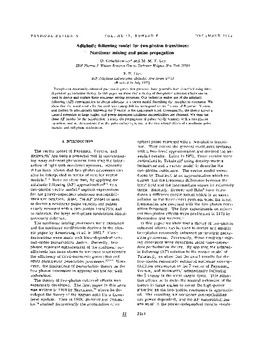| dc.contributor.author | Grischkowsky, D. | |
| dc.contributor.author | Loy, M. M. T. | |
| dc.contributor.author | Liao, P. F. | |
| dc.date.accessioned | 2015-10-16T20:48:18Z | |
| dc.date.available | 2015-10-16T20:48:18Z | |
| dc.date.issued | 1975-12 | |
| dc.identifier | okds_Grischkowsky_PRA_1975-12 | |
| dc.identifier.citation | Grischkowsky, D., Loy, M. M. T., & Liao, P. F. (1975). Adiabatic following model for two-photon transitions: Nonlinear mixing and pulse propagation. Physical Review A, 12(6), 2514-2533. https://doi.org/10.1103/PhysRevA.12.2514 | |
| dc.identifier.uri | https://hdl.handle.net/11244/19894 | |
| dc.description.abstract | Two-photon resonantly enhanced parametric generation processes have generally been described using time-dependent perturbation theory. In this paper we show that a theory of two-photon coherent effects can be used to derive and explain these nonlinear mixing processes. Our technique makes use of the adiabatic following (AF) approximation to obtain solutions to a vector model describing the two-photon resonance. We show that the usual results for the nonlinear susceptibilities correspond to the r vector of Feynman, Vernon, and Hellwarth adiabatically following the gamma vector in the small-angle limit. Consequently, the theory allows a natural extension to large angles, and power-dependent nonlinear susceptibilities are obtained. We then use these AF results for the polarization to study the propagation of pulses nearly resonant with a two-photon transition, and we demonstrate that the pulse reshaping is due to the two related effects of a nonlinear pulse velocity and self-phase modulation. | |
| dc.format | application/pdf | |
| dc.language | en_US | |
| dc.publisher | American Physical Society | |
| dc.rights | This material has been previously published. In the Oklahoma State University Library's institutional repository this version is made available through the open access principles and the terms of agreement/consent between the author(s) and the publisher. The permission policy on the use, reproduction or distribution of the material falls under fair use for educational, scholarship, and research purposes. Contact Digital Resources and Discovery Services at lib-dls@okstate.edu or 405-744-9161 for further information. | |
| dc.title | Adiabatic following model for two-photon transitions: Nonlinear mixing and pulse propagation | |
| osu.filename | okds_Grischkowsky_PRA_1975-12.pdf | |
| dc.description.peerreview | Peer reviewed | |
| dc.identifier.doi | 10.1103/PhysRevA.12.2514 | |
| dc.description.department | Electrical and Computer Engineering | |
| dc.type.genre | Article | |
| dc.type.material | Text | |
| dc.subject.keywords | nonlinear mixing | |
| dc.subject.keywords | pulse propagation | |
| dc.subject.keywords | adiabatic following approximation | |
| dc.subject.keywords | nonlinear susceptibilities | |
| dc.subject.keywords | nonlinear pulse velocity | |
| dc.subject.keywords | pulse reshaping | |
| dc.subject.keywords | two photon transitions | |
